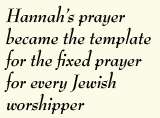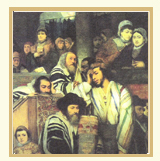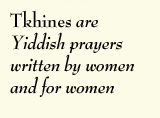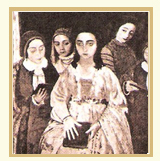Liturgical Precedent
Introduction
Hannah’s prayer became the basis of many important laws of prayer in Judaism. From Hannah’s silent prayer and Eli’s reaction to it, the rabbis learn the laws of the Amida (link), referred to in the Talmud as Tefillah; the definitive and main act of Jewish prayer. Interestingly enough, the rabbis focus more on the form of Hannah’s prayer and less on the content. The way Hannah prayed became the “how-to guide” for future generations:
One should not stand up to say Tefillah save in a reverent frame of mind . . . What is the [Scriptural] source of this rule? R. Elazar said: Scripture says, “And she was in bitterness of soul.”
(b. Berachot 30b)
I might say that he should let his voice be heard in praying. It has already been clearly stated by Hannah, as is said, “But her voice could not be heard.”
(b. Berachot 31a)
R. Hamnuna said: How many major laws can be learnt from these verses relating to Hannah!
Now Hannah, she spoke in her heart: from this we learn that one who prays must direct his heart.
Only her lips moved: from this we learn that he who prays must frame the words distinctly with his lips.
But her voice could not be heard: from this, it is forbidden to raise one’s voice in the Tefillah.
Therefore Eli thought she had been drunken: from this, that a drunken person is forbidden to say the Tefillah.
(b. Berachot 31a)
I am the woman that stood by Thee here. R. Joshua b. Levi said: From this we learn that it is forbidden to sit within four cubits of one saying Tefillah.
(b. Berachot 31b)
Hannah’s prayer—a deeply private and personal cry of a barren woman to God—surprisingly became, through rabbinic and legal interpretation and application, the template for the fixed, prayer for every Jewish worshipper (tfillat keva). Standardized prayer gives expression to a panoply of feelings. Reciting canonized prayers ties the worshipper to previous generations of pray-ers that were answered. Standard prayers remind individuals, in their loneliness, that they are part of a larger community coping with similar issues, and thereby, provide strength and hope. [1]B.S. Jacobson, “Spontaneous vs. Standardized Prayer – On Fixed Times for Prayer”, in Meditations on the Siddur, (Tel Aviv, 1966), pp. 28-36
Whereas Hannah’s prayer served as the springboard for standardized prayer in many respects, {Hannah’s prayer was instituted as the haftarah on the first day of Rosh Hashanah, as well as in the Sefardi daily prayer.
it also left room for spontaneous prayer. Her prayer defined “worship of the heart” in a way that had never been known before. Hannah was an inspiration for women throughout the ages to turn to God in times of personal need and distress.
Tkhines
Fine examples of this phenomenon are the tkhines – Yiddish prayers written by women and for women beginning in the sixteenth century. These original liturgical compositions called tkhines—literally, supplications or pleas. Often they were a loose translation of the Hebrew liturgy with some additions from the original Hebrew vernacular, and sometimes they were completely original.
Many of these tkhines were linked to the Hebrew liturgy found in the siddur and were intended for recitation in the synagogue. Others were said at home either while observing certain mitzvoth or at critical junctures in the woman’s family life cycle.
One such tkhine, inspired by Hannah, was written for pregnant women to prevent miscarriage:
I entreat you, Lord, God of Israel, accept my prayer, just as you accepted the prayer of our mother, Hannah the prophetess, which she prayed for her son, Samuel the prophet. And may her merit assist me, so that I, your maidservant, may bear to full term this child that I now carry in my womb—your creation—and that a healthy child may emerge. May he be a pious Jew, may he serve You with all his heart and soul, may he love Torah and be in awe of heaven, according to Your holy will, and may he be a beautiful seedling in the Jewish vineyard for the glory of Israel. Amen.[2]Tracy Guren Klirs, The Merit of Our Mothers—A Bilingual Anthology of Jewish Women’s Prayers, Cincinnati: HUC, 1992, 124–125
In Sefardi tradition as well, a “para-liturgy” developed parallel to the synagogue prayer. Women were the main singers of Ladino religious songs at ceremonial gatherings and celebrations. Although many of these prayers had a personal, intimate tone and were a part of women’s private devotions, these songs differ from the tkhines in that they were routinely sung aloud both at women-only gatherings and at community-wide celebrations.
In the following blessing from a Sarejevo Ladino machzor, a mother prays on Yom Kippur, asking that God grant her children mazal—a favorable destiny and prosperity. Thanking the merciful God for having granted her long life and children by her side, she says:
Holy Father
In this clear and solemn hour
In which I find myself to
Bless my children
As a mother who feels deeply
Be, O God, always and quickly
ready to listen in the high heavens,
to my prayer and the blessing that
I give my children
My God
You lengthened my life
By giving me children to stay by my side.
Be benevolent to me and
present them with a good life
and good fortune
And may I merit to see, with my
eyes, their mazal
and their flowering prosperity
Merciful Father.[3]“La Bendision de Madre” from The Flory Jagoda Songbook, New York: Tara Publications, 1993
Hannah’s Evolving Relationship with God
The biblical text presents Hannah’s prayer in bold strokes. Hannah weeps, prays, and bargains with the Almighty. She stresses her pain and suffering as well as her loyal devotion to God. She vows that she will dedicate her child to the service of the Lord and make him a Nazarite (link). Although the consecration of her son can be seen as an attempt at “putting pressure” on God to fulfill her request, it can also be seen as an act of unprecedented altruism.
Hannah drove a hard bargain (link midrashim) and her prayers were answered — she was blessed with a child. After he was weaned, Hannah returned to the site of her first prayer with the son she prayed for in hand. Again her voice is heard in higher registers. Hannah’s song takes prayer to its ultimate heights.
And Hannah prayed:
My heart exults in the Lord;
I have triumphed through the Lord,
I gloat over my enemies
I rejoice in Your deliverance.
There is no holy one like the Lord,
Truly, there is none beside You;
There is no rock like our God. (1 Sam 2:1–2)
Listening to her voice we witness Hannah’s personal transformation.
Hannah moves from silence to speech. In scene 1, she speaks not all. She is irritated, vexed, weeping, and unable to eat. She has no power to be present in the story. In scene 2, Hannah begins to speak. She speaks out of affliction. Her first speech is addressed to God out of her deep need (v. 10-11). This is followed by a second articulation of need, this to Eli (v. 15-16). There is still no move beyond pitiful need. In the third scene, Hannah is the only one who speaks. Now she speaks freely, boldly, exultantly as the one who has been heard and remembered.
In scene 4, Hannah speaks a long, buoyant affirmation to Eli. A painful process of hurt voiced and gift received permit her to enter Israel’s historical arena with authority and speech. Hannah is the voice of the gospel making history possible among the marginal who, through her, receive their voice.[4]Walter Brueggemann, I Samuel 1: A Sense of a Beginning, 42–43?
Hannah’s prayer is quoted in full in the Bible; transforming her into the symbol of prayer. Because she prayed in the House of God – the tabernacle at Shiloh, (link: Women would bring sacrifices to Shiloh, for example, after giving birth or miscarrying. This Torah ordinance of the sacrifice of a birthing woman continued through Temple times.) Hannah provided the opportunity for women’s voices to be heard in houses of prayer.
References
| ↑1 | B.S. Jacobson, “Spontaneous vs. Standardized Prayer – On Fixed Times for Prayer”, in Meditations on the Siddur, (Tel Aviv, 1966), pp. 28-36 |
|---|---|
| ↑2 | Tracy Guren Klirs, The Merit of Our Mothers—A Bilingual Anthology of Jewish Women’s Prayers, Cincinnati: HUC, 1992, 124–125 |
| ↑3 | “La Bendision de Madre” from The Flory Jagoda Songbook, New York: Tara Publications, 1993 |
| ↑4 | Walter Brueggemann, I Samuel 1: A Sense of a Beginning, 42–43? |




